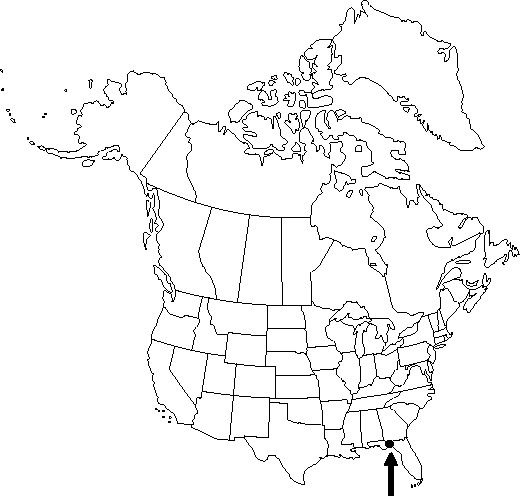Difference between revisions of "Torreya taxifolia"
Ann. Nat. Hist. 1: 130. 1838.
FNA>Volume Importer |
imported>Volume Importer |
||
| (7 intermediate revisions by 2 users not shown) | |||
| Line 8: | Line 8: | ||
}} | }} | ||
|common_names=Florida torreya;stinking-cedar;gopherwood | |common_names=Florida torreya;stinking-cedar;gopherwood | ||
| + | |special_status={{Treatment/ID/Special_status | ||
| + | |code=E | ||
| + | |label=Endemic | ||
| + | }}{{Treatment/ID/Special_status | ||
| + | |code=C | ||
| + | |label=Conservation concern | ||
| + | }} | ||
|basionyms= | |basionyms= | ||
|synonyms={{Treatment/ID/Synonym | |synonyms={{Treatment/ID/Synonym | ||
|name=Tumion taxifolium | |name=Tumion taxifolium | ||
|authority=(Arnott) Greene | |authority=(Arnott) Greene | ||
| + | |rank=species | ||
}} | }} | ||
|hierarchy=Taxaceae;Torreya;Torreya taxifolia | |hierarchy=Taxaceae;Torreya;Torreya taxifolia | ||
| Line 20: | Line 28: | ||
}}<!-- | }}<!-- | ||
| − | --><span class="statement" id="st- | + | --><span class="statement" id="st-undefined" data-properties=""><b>Trees </b>to 13(–18) m; trunk to 8 dm diam.; crown rather open-conical. <b>Branches</b> spreading to slightly drooping; 2-year-old branches yellowish green, yellowish brown, or gray. <b>Leaves</b> 1.5–3.8 cm, abaxial side with 2 scarcely impressed, grayish bands of stomates, rounded on adaxial side, emitting fetid odor when crushed. <b>Pollen</b> cones pale yellow. <b>Seed</b> (including aril) 2.5–3.5 cm; aril glaucous, dark green, streaked with purple.</span><!-- |
-->{{Treatment/Body | -->{{Treatment/Body | ||
| Line 26: | Line 34: | ||
|elevation=15–30 m | |elevation=15–30 m | ||
|distribution=Fla.;Ga. | |distribution=Fla.;Ga. | ||
| − | |discussion=<p>Torreya taxifolia is a rare endemic mainly along the Apalachicola River.</p><!-- | + | |discussion=<p><i>Torreya taxifolia</i> is a rare endemic mainly along the Apalachicola River.</p><!-- |
| − | --><p>Populations of Torreya taxifolia were thriving until the 1950s, but since then they have been decimated by fungal disease (R. L. Godfrey and H. Kurz 1962). Only nonreproductive stump sprouts remain in the wild. The Florida torreya was listed as federally endangered in 1984 under the U.S. Endangered Species Act, and efforts are underway to reestablish this once thriving species in its native habitat (L. R. McMahan 1989).</p><!-- | + | --><p>Populations of <i>Torreya taxifolia</i> were thriving until the 1950s, but since then they have been decimated by fungal disease (R. L. Godfrey and H. Kurz 1962). Only nonreproductive stump sprouts remain in the wild. The Florida torreya was listed as federally endangered in 1984 under the U.S. Endangered Species Act, and efforts are underway to reestablish this once thriving species in its native habitat (L. R. McMahan 1989).</p><!-- |
--><p>Of conservation concern.</p> | --><p>Of conservation concern.</p> | ||
|tables= | |tables= | ||
| Line 58: | Line 66: | ||
-->{{#Taxon: | -->{{#Taxon: | ||
name=Torreya taxifolia | name=Torreya taxifolia | ||
| − | |||
|authority=Arnott | |authority=Arnott | ||
|rank=species | |rank=species | ||
| Line 71: | Line 78: | ||
|publication title=Ann. Nat. Hist. | |publication title=Ann. Nat. Hist. | ||
|publication year=1838 | |publication year=1838 | ||
| − | |special status= | + | |special status=Endemic;Conservation concern |
| − | |source xml=https:// | + | |source xml=https://bitbucket.org/aafc-mbb/fna-data-curation/src/2e0870ddd59836b60bcf96646a41e87ea5a5943a/coarse_grained_fna_xml/V2/V2_729.xml |
|genus=Torreya | |genus=Torreya | ||
|species=Torreya taxifolia | |species=Torreya taxifolia | ||
| − | |||
| − | |||
| − | |||
| − | |||
| − | |||
| − | |||
| − | |||
| − | |||
| − | |||
| − | |||
| − | |||
| − | |||
| − | |||
| − | |||
| − | |||
| − | |||
| − | |||
}}<!-- | }}<!-- | ||
-->[[Category:Treatment]][[Category:Torreya]] | -->[[Category:Treatment]][[Category:Torreya]] | ||
Latest revision as of 20:25, 5 November 2020
Trees to 13(–18) m; trunk to 8 dm diam.; crown rather open-conical. Branches spreading to slightly drooping; 2-year-old branches yellowish green, yellowish brown, or gray. Leaves 1.5–3.8 cm, abaxial side with 2 scarcely impressed, grayish bands of stomates, rounded on adaxial side, emitting fetid odor when crushed. Pollen cones pale yellow. Seed (including aril) 2.5–3.5 cm; aril glaucous, dark green, streaked with purple.
Habitat: River bluffs, slopes, and moist ravines
Elevation: 15–30 m
Discussion
Torreya taxifolia is a rare endemic mainly along the Apalachicola River.
Populations of Torreya taxifolia were thriving until the 1950s, but since then they have been decimated by fungal disease (R. L. Godfrey and H. Kurz 1962). Only nonreproductive stump sprouts remain in the wild. The Florida torreya was listed as federally endangered in 1984 under the U.S. Endangered Species Act, and efforts are underway to reestablish this once thriving species in its native habitat (L. R. McMahan 1989).
Of conservation concern.
